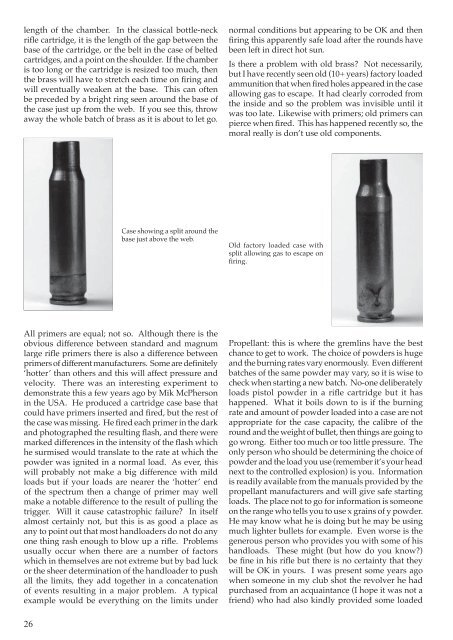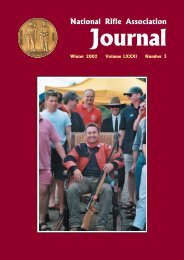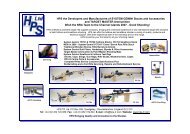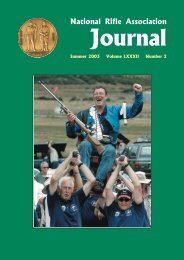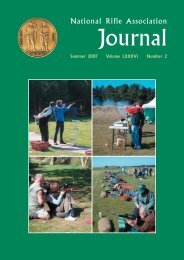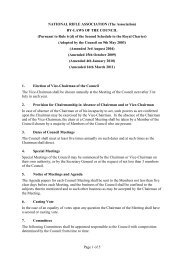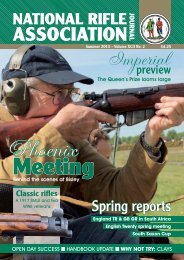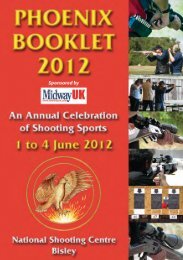length of the chamber. In the classical bottle-neckrifle cartridge, it is the length of the gap between thebase of the cartridge, or the belt in the case of beltedcartridges, and a point on the shoulder. If the chamberis too long or the cartridge is resized too much, thenthe brass will have to stretch each time on firing andwill eventually weaken at the base. This can oftenbe preceded by a bright ring seen around the base ofthe case just up from the web. If you see this, throwaway the whole batch of brass as it is about to let go.normal conditions but appearing to be OK and thenfiring this apparently safe load after the rounds havebeen left in direct hot sun.Is there a problem with old brass? Not necessarily,but I have recently seen old (10+ years) factory loadedammunition that when fired holes appeared in the caseallowing gas to escape. It had clearly corroded fromthe inside and so the problem was invisible until itwas too late. Likewise with primers; old primers canpierce when fired. This has happened recently so, themoral really is don’t use old components.Case showing a split around thebase just above the web.Old factory loaded case withsplit allowing gas to escape onfiring.All primers are equal; not so. Although there is theobvious difference between standard and magnumlarge rifle primers there is also a difference betweenprimers of different manufacturers. Some are definitely‘hotter’ than others and this will affect pressure andvelocity. There was an interesting experiment todemonstrate this a few years ago by Mik McPhersonin the USA. He produced a cartridge case base thatcould have primers inserted and fired, but the rest ofthe case was missing. He fired each primer in the darkand photographed the resulting flash, and there weremarked differences in the intensity of the flash whichhe surmised would translate to the rate at which thepowder was ignited in a normal load. As ever, thiswill probably not make a big difference with mildloads but if your loads are nearer the ‘hotter’ endof the spectrum then a change of primer may wellmake a notable difference to the result of pulling thetrigger. Will it cause catastrophic failure? In itselfalmost certainly not, but this is as good a place asany to point out that most handloaders do not do anyone thing rash enough to blow up a rifle. Problemsusually occur when there are a number of factorswhich in themselves are not extreme but by bad luckor the sheer determination of the handloader to pushall the limits, they add together in a concatenationof events resulting in a major problem. A typicalexample would be everything on the limits underPropellant: this is where the gremlins have the bestchance to get to work. The choice of powders is hugeand the burning rates vary enormously. Even differentbatches of the same powder may vary, so it is wise tocheck when starting a new batch. No-one deliberatelyloads pistol powder in a rifle cartridge but it hashappened. What it boils down to is if the burningrate and amount of powder loaded into a case are notappropriate for the case capacity, the calibre of theround and the weight of bullet, then things are going togo wrong. Either too much or too little pressure. Theonly person who should be determining the choice ofpowder and the load you use (remember it’s your headnext to the controlled explosion) is you. Informationis readily available from the manuals provided by thepropellant manufacturers and will give safe startingloads. The place not to go for information is someoneon the range who tells you to use x grains of y powder.He may know what he is doing but he may be usingmuch lighter bullets for example. Even worse is thegenerous person who provides you with some of hishandloads. These might (but how do you know?)be fine in his rifle but there is no certainty that theywill be OK in yours. I was present some years agowhen someone in my club shot the revolver he hadpurchased from an acquaintance (I hope it was not afriend) who had also kindly provided some loaded26
ammunition with the revolver. The first shot blewone of the chambers out of the cylinder.Most handloaders have more than one choice ofpowder to hand and it is always recommended to havejust one can at a time open on the bench. Commonsense, of course, but the possibilities for error areendless. Dumping the remaining powder from thepowder measure into the wrong container etc etc. Itis also possible to have some of the powder chargefrom the measure to ‘hang’ in the measure drop tubeso one case gets a short charge whilst the next getsmore than its fair share. Recently at Bisley, pullingthe bullets from a batch of suspect rounds showedvery wide variation in powder charge. The cause wasnever really identified in this case but the fact is thisis not merely speculation - it does happen.Something to bear in mind when trying the old tubof powder with a bit left from a couple of years ago,is that powder contains moisture and other solvents.Leaving powder open to the air will rapidly changethe moisture content and thus its burning rate. Ifpossible, keep powder bottles as full as possible. Anear empty bottle risks allowing the powder to dryout into the large air space.Bullet weight will make a notable difference topressures generated and if you are trying differentbullet weights, make sure the load is appropriate– heavier bullets equals less powder. Bullet seatingdepth will affect pressures generated. If the bullet isseated into the lands as is common for VLD bulletsthere will be higher pressures on firing than if thebullet is seated off the lands, and of course a long bulletjump (‘freebore’) has been used by rifle manufacturersin the past to enable heavier loads to be used withoutcausing excess pressure.Even bullets of similar weight may behave verydifferently if the length of the bearing surface (the flatbit on the side of the bullet!) is different. The longerthe bearing surface, the more resistance there will be tobeing engraved by the rifling and therefore the higherthe pressure on firing.Seriously stressed primer pocketThat just about covers the components, but thingsdon’t end there. Things can go wrong even with themost knowledgable and experienced handloader. Theillustration shows a case head that has been subjectedto monumental pressure. Fortunately this occured ina modern well-designed action. How did it happen?“Competition coming up, pressure of work - no timeto test before-hand, new components etc etc – the usualload should have been fine”. Yes, on paper it reallyshould have been, but somehow, things conspiredto make sure this was not so and this case was theresult.Handloading can get addictive and the search for theultimate in accuracy can lead to greater excess up toand including doing your own gunsmithing. This isa good place to point out that whilst the law does notrequire proof testing of firearms that are not sold toa third party, the <strong>NRA</strong> strongly recommends that allfirearms are proofed before use.Let’s look on the positive side. One of the mostimportant tools you can have on the reloading benchis the bullet puller. They are cheap and quick to use.When in doubt, pull the bullet from the round andcheck the powder and the load. Another safety aid isa digital scale. There is nothing wrong with a beambalance but a digital scale is so quick to use it is noproblem to check weigh rounds if, for example, yoususpect you might have given one a double charge.Getting a bit more sophisticated, there are computerprogrammes (eg QuickLoad) which allow you toassess powder, cartridge and bullet combinations;their predictions of muzzle velocity are pretty good.That suggests that the information they provide onpressures generated within the chamber is going tobe reasonably accurate. This can be a great help whenstarting to load with a new set of components.This is a very basic look at some of the causes of excesspressure in fullbore rifle handloads and is not meantto insult the knowledgeable reader. As stated at thebeginning, the aim is to learn from the problems thatdo occur and hopefully help to avoid them in thefuture. The focus is on fullbore rifle handloading asthe opportunities for problems are greater. That is notto say gallery rifles firing pistol cartridges and longbarrel revolvers cannot have problems. Giving a case adouble powder charge is easier with the small volumesof fast pistol powders used when compared with theslower and bulkier rifle powders. Again, less commonwith fullbore rifles is getting a bullet left in the barrelfrom a ‘primer special’ (primer but no powder), theshooter not noticing and then firing again. Makes aninteresting shaped barrel!To sum up, the key elements are simple: know whatyou are doing and do it carefully. Easy, really.27


